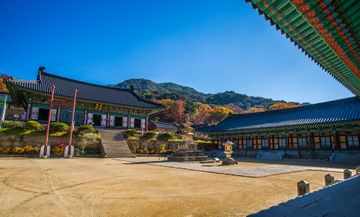"수행 및 예불 공간(합천 해인사)"의 두 판 사이의 차이
(→영문) |
(→영문) |
||
| 28번째 줄: | 28번째 줄: | ||
(Place of Buddhist practice and worship) | (Place of Buddhist practice and worship) | ||
| − | Haeinsa Temple grounds can be | + | Haeinsa Temple grounds can be divided into three large areas: the main section where the relics or remains of the Buddha were enshrined, a section where Buddhist scriptures were taught and published, and a section where monks practiced meditation. The first one, ''bulbo'' area, is for worship, and it includes Daejeokgwangjeon Hall. The second one, ''beopbo'' area is the space of teaching, and it includes the Janggyeongpanjeon Depositories with Buddhist texts. The third one, ''seungbo'' area, consists of an open space with the main temple accessible to laymen and a space where monks live and carry out their duties. Together these three areas represent the three objects of Buddhist veneration that are looked forward for guidance and taken refuge in: '' bulbo'', the Buddha, or the Awakened One, which can refer either to the historical Buddha or the Buddhahood that he represents; ''beopbo'', the teachings of the Buddha; and the ''seungbo'', the community of those who practice to attain awakening and help the laymen to do the same. |
| − | The | + | The ''bulbo'' area consists mainly of buildings used for religious purposes, that is worship and prayers. To the left from Daejeokgwangjeon Hall, where Vairocana Buddha is enshrined, stand Daebirojeon Hall and Dokseonggak Pavilion, and to the right are Myeongbujeon Hall and Eungjinjeon Hall. |
| − | The '' | + | The buildings of the ''seungbo'' area are mainly used by the monks who attend the Buddhist University. Among the buildings on the left side of the central courtyard beneath the Daejeokgwangjeon Hall are Gunghyeondang Hall, which is used by university lecturers, and Jeongmukdang Hall, monks’ quarters. To the right side of the central courtyard, is Gwaneumjeon Hall, also presently used by the university. |
| + | |||
| + | * I changed the arrangement, do it's 순서 is consistent | ||
===영문 해설 내용=== | ===영문 해설 내용=== | ||
2020년 4월 16일 (목) 12:59 판
| 수행 및 예불 공간 |
|
 엽토51, 해인사 대적광전의 주변전각과 문화재, 쏠쏠한 일상, 네이버 블로그. |
|
| 대표명칭 | 수행 및 예불 공간 |
|---|---|
| 한자 | 修行 및 禮佛空間 |
| 주소 | 경상남도 합천군 가야면 해인사길 122 |
|
|
|
해설문
국문
정중탑과 석등이 있는 마당 좌우로 궁현당*과 관음전이 있다. 궁현당 너머에는 적묵당과 조사전이, 관음전 너머에 정수당이 있다. 이들 전각은 대부분 해인사 승가대학(강원) 스님들의 수행공간이다. 높은 축대 위에 솟은 대적광전을 중심으로 왼쪽의 대비로전과 독성각, 오른쪽의 명부전과 응진전은 예불, 참회, 기도 등 주요 종교 활동이 이루어지는 예불공간이다. 대적광전은 비로자나불을 본존불로 모신 해인사의 중심 법당이며, 대비로전은 9세기에 조성된 국내 최고(最古)의 목조 비로자나불을 봉안하고 있다. 응진전 뒤쪽에는 한때 선원으로 사용되었던 선열당(법계당), 퇴설당이 있다.
영문
(Place of Buddhist practice and worship)
Haeinsa Temple grounds can be divided into three large areas: the main section where the relics or remains of the Buddha were enshrined, a section where Buddhist scriptures were taught and published, and a section where monks practiced meditation. The first one, bulbo area, is for worship, and it includes Daejeokgwangjeon Hall. The second one, beopbo area is the space of teaching, and it includes the Janggyeongpanjeon Depositories with Buddhist texts. The third one, seungbo area, consists of an open space with the main temple accessible to laymen and a space where monks live and carry out their duties. Together these three areas represent the three objects of Buddhist veneration that are looked forward for guidance and taken refuge in: bulbo, the Buddha, or the Awakened One, which can refer either to the historical Buddha or the Buddhahood that he represents; beopbo, the teachings of the Buddha; and the seungbo, the community of those who practice to attain awakening and help the laymen to do the same.
The bulbo area consists mainly of buildings used for religious purposes, that is worship and prayers. To the left from Daejeokgwangjeon Hall, where Vairocana Buddha is enshrined, stand Daebirojeon Hall and Dokseonggak Pavilion, and to the right are Myeongbujeon Hall and Eungjinjeon Hall.
The buildings of the seungbo area are mainly used by the monks who attend the Buddhist University. Among the buildings on the left side of the central courtyard beneath the Daejeokgwangjeon Hall are Gunghyeondang Hall, which is used by university lecturers, and Jeongmukdang Hall, monks’ quarters. To the right side of the central courtyard, is Gwaneumjeon Hall, also presently used by the university.
- I changed the arrangement, do it's 순서 is consistent
영문 해설 내용
해인사의 공간 구성은 크게 가람에 진입하는 구역인 외호공간과 스님들이 수행하며 생활하는 승보공간, 대적광전 등 예불을 위한 불보공간, 장경판전이 있는 법보공간으로 나눌 수 있다.
승보공간에 있는 전각들은 대부분 해인사 승가대학 스님들의 수행 공간이다. 대적광전 아래 마당을 중심으로 왼편에는 승가대학의 교사 건물로 쓰이는 궁현당과 요사채로 쓰이는 적묵당 등이 있다. 오른편에는 역시 승가대학 건물로 쓰이는 관음전이 자리하고 있다.
불보공간에는 예불과 기도회 등 주요 종교 활동이 이루어지는 전각들이 배치되어 있다. 비로자나불을 모시는 대적광전을 중심으로 왼쪽에는 대비로전과 독성각이 있고 오른쪽에는 명부전과 응진전이 있다.
참고 자료
- 伽倻山 海印寺 산내 庵子의 입지와 공간구성에 대한 풍수지리적 연구, 임금선, 영남대학교 석사학위논문, 2013.
- 해인사 http://www.haeinsa.or.kr/bbs/content.php?co_id=1050